
The Codex Manesse is a Liederhandschrift, the single most comprehensive source of Middle High German Minnesang poetry, written and illustrated between c. 1304 when the main part was completed, and c. 1340 with the addenda.
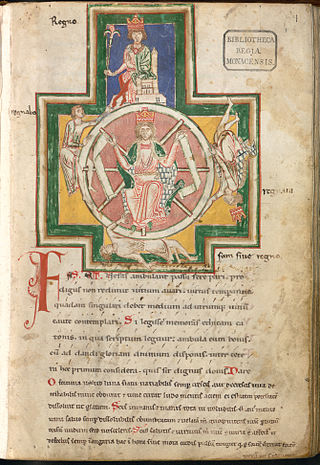
Carmina Burana is a manuscript of 254 poems and dramatic texts mostly from the 11th or 12th century, although some are from the 13th century. The pieces are mostly bawdy, irreverent, and satirical. They were written principally in Medieval Latin, a few in Middle High German and old Arpitan. Some are macaronic, a mixture of Latin and German or French vernacular.

The Nibelungenlied, translated as The Song of the Nibelungs, is an epic poem written around 1200 in Middle High German. Its anonymous poet was likely from the region of Passau. The Nibelungenlied is based on an oral tradition of Germanic heroic legend that has some of its origin in historic events and individuals of the 5th and 6th centuries and that spread throughout almost all of Germanic-speaking Europe. Scandinavian parallels to the German poem are found especially in the heroic lays of the Poetic Edda and in the Völsunga saga.
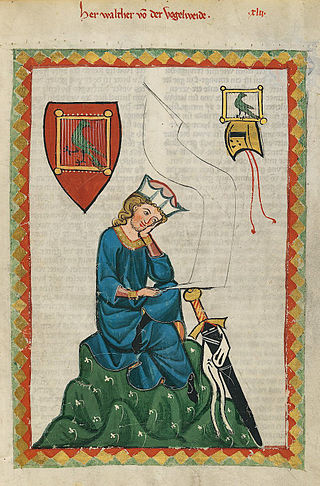
Minnesang was a tradition of lyric- and song-writing in Germany and Austria that flourished in the Middle High German period. This period of medieval German literature began in the 12th century and continued into the 14th. People who wrote and performed Minnesang were known as Minnesänger, and a single song was called a Minnelied.

Wolfram von Eschenbach was a German knight, poet and composer, regarded as one of the greatest epic poets of medieval German literature. As a Minnesinger, he also wrote lyric poetry.

Walther von der Vogelweide was a Minnesänger who composed and performed love-songs and political songs ("Sprüche") in Middle High German. Walther has been described as the greatest German lyrical poet before Goethe; his hundred or so love-songs are widely regarded as the pinnacle of Minnesang, the medieval German love lyric, and his innovations breathed new life into the tradition of courtly love. He was also the first political poet to write in German, with a considerable body of encomium, satire, invective, and moralising.
Poetry took numerous forms in medieval Europe, for example, lyric and epic poetry. The troubadours, trouvères, and the minnesänger are known for composing their lyric poetry about courtly love usually accompanied by an instrument.
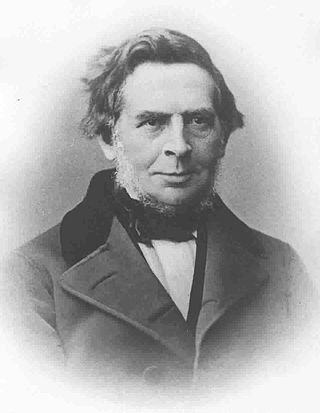
Karl Joseph Simrock was a German poet and writer. He is primarily known for his translation of Das Nibelungenlied into modern German.
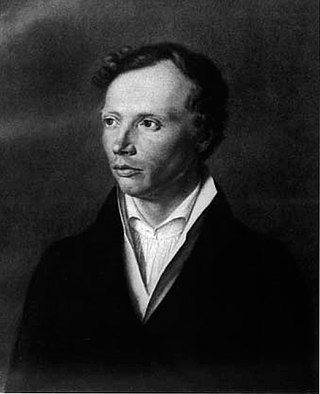
Johann Ludwig Uhland was a German poet, philologist and literary historian.
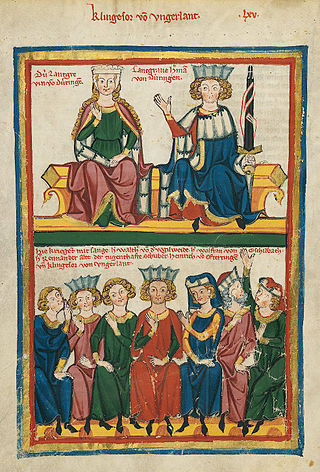
Heinrich von Ofterdingen is a fabled, quasi-fictional Middle High German lyric poet and Minnesinger mentioned in the 13th-century epic of the Sängerkrieg on the Wartburg. The legend was revived by Novalis in his eponymous fragmentary novel written in 1800 and by E. T. A. Hoffmann in his 1818 novella Der Kampf der Sänger.
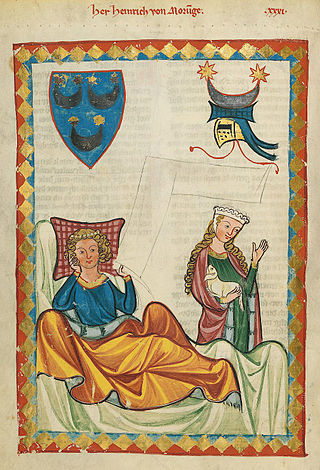
Heinrich von Morungen was a Minnesinger, whose 35 surviving Middle High German songs are dated on both literary and biographical grounds to around the period 1190–1200. Alongside Walter von der Vogelweide and Reinmar he is regarded as one of the most important Minnesänger: he was "the most colourful, passionate, tender and musical of the Minnesänger" and his work "marks a new and brilliantly effective stage in the development of the German lyric."

The Palästinalied is a crusade song written in the early 13th century by Walther von der Vogelweide, the most celebrated lyric poet of Middle High German literature. It is one of the few songs by Walther for which a melody has survived.

Albrecht von Johansdorf was a Minnesänger and a minor noble in the service of Wolfger of Erla. Documents indicate that his life included the years 1185 to 1209. He may have known Walther von der Vogelweide and is believed to have participated in a crusade. He is known to have written at least five "recruitment" songs in Middle High German, most likely for the Third Crusade. His "Song 2" owes a debt to the structure and melody from a song in Old French by trouvère poet Conon de Béthune. His "Song 5", which mentions the capture of Jerusalem, may suggest that he wrote around 1190. Von Johansdorf's Minnelieder conform outwardly to the standard pattern of man subordinating himself to the woman above him and is responsible for the classical formulation of "the educative value of Minnedienst". His integrity and warmth of heart are most evident in poems referring to the departure for the crusade.

Reinmar von Hagenau was a German Minnesänger of the late twelfth century who composed and performed love-songs in Middle High German. He was regarded by his contemporaries as the greatest Minnesänger before Walther von der Vogelweide, a view widely shared by modern scholars. Although there are uncertainties as to which songs can be reliably attributed to him, a substantial body of his work — over 60 songs — survives. His presentation of courtly love as the unrequited love of a knight for a lady is "the essence of classical Minesang".
A Crusade song is any vernacular lyric poem about the Crusades. Crusade songs were popular in the High Middle Ages: 106 survive in Occitan, forty in Old French, thirty in Middle High German, two in Italian, and one in Old Castilian. The study of the Crusade song, which may be considered a genre of its own, was pioneered by Kurt Lewent. He provided a classification of Crusade songs and distinguished between songs which merely mentioned, in some form, a Crusade from songs which were "Crusade songs". Since Lewent, scholars have added several classifications and definitions of Crusade songs. Scholars have argued for three different classifications of Crusade songs which include songs of exhortation, love songs, and songs which criticize the Crusading movement.

Thomasin von Zirclaere, also called Thomasîn von Zerclaere or Tommasino Di Cerclaria was an Italian Middle High German lyric poet. The epic poem Der Wälsche Gast is the only preserved work by him.

Spruchdichtung or Sangspruchdichtung is the German term for a genre of Middle High German sung verse. An individual work in this genre is called a Spruch, literally a "saying", and may consist of one or more strophes.
Middle High German literature refers to literature written in German between the middle of the 11th century and the middle of the 14th. In the second half of the 12th century, there was a sudden intensification of activity, leading to a 60-year "golden age" of medieval German literature referred to as the mittelhochdeutsche Blütezeit. This was the period of the blossoming of Minnesang, MHG lyric poetry, initially influenced by the French and Provençal tradition of courtly love song. The same sixty years saw the composition of the most important courtly romances. again drawing on French models such as Chrétien de Troyes, many of them relating Arthurian material. The third literary movement of these years was a new revamping of the heroic tradition, in which the ancient Germanic oral tradition can still be discerned, but tamed and Christianized and adapted for the court.

The lime tree, or linden, (Tilia) is important in the mythology, literature, and folklore of a number of cultures.
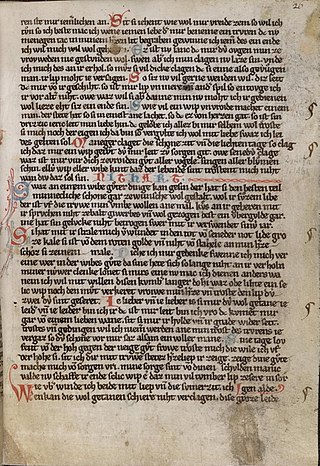
The Kleine Heidelberger Liederhandschift is a collection of Middle High German Minnesang texts. In Minnesang scholarship it is referred to as MS. A. It is held by the Heidelberg University Library with the signature Cod.Pal.germ. 357.















